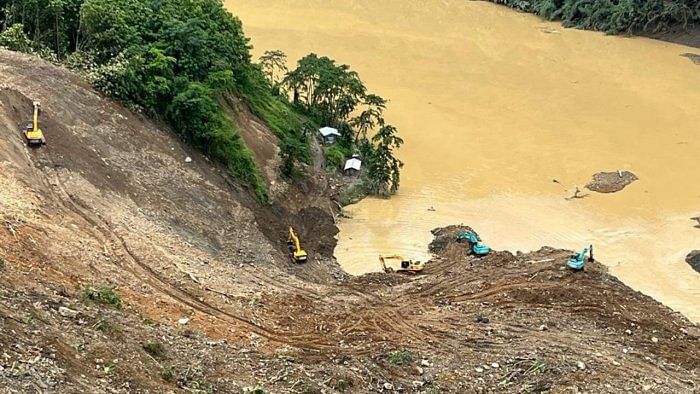
The massive landslide that buried an under construction railway yard in Manipur's Noney district on the night of June 27 brought the focus to the hilly Northeast's aggravating problem of landslides.
A total of 40 bodies were retrieved till Sunday while the search was underway for another 22, who remained traceless since the landslide struck them near Tupul railway yard.
Flood and landslide is a routine phenomenon in the disaster-prone Northeast but the problem is aggravating every year in the region. Data available with the state disaster management authorities show that at least 109 people have died in Assam since April when the pre-monsoon showers hit the region.
Also Read | 8 from Assam killed in Manipur landslide; state government to airlift bodies of civilians
The deaths have been reported in Assam (18), Meghalaya (34), Arunachal Pradesh (17) and Manipur (40, including Noney incident). Heavy rains in the second week of May wreaked havoc in Assam's hill district, Dima Hasao, which witnessed massive landslides on the hills triggering flash floods. As mud and slush flowed down the hills, the debris blocked rail tracks and stations, resulting breach in several stretches of the railway tracks under Lumding-Badarpur section. Rail communication in the section has still remained snapped.
According to experts, although landslides are not new in the Northeast, the changing precipitation pattern and destruction of hills for construction of roads and railway tracks was aggravating the problem.
"Very heavy rainfall in a short period of time is becoming the norm, rather than the continuous light drizzle that the region was known for. Our existing infrastructure was not built to withstand such intense weather anomalies and so we are witnessing such destructive impacts," said Rituraj Phukan, a climate activist in Assam.
Assam alone received 1,891.9mm of rainfall between March 1 and June 24, just 347.5 mm less than the annual rains the state receives.
Also Read: Manipur adopts 1961 as 'base year' to determine 'native residents' for ILP implementation
As the Centre pressed for completion of the major infrastructure projects in the Northeast, such as the Jiribam-Imphal rail project in Manipur and the highway projects in the hilly Arunachal Pradesh and Nagaland before the 2024 Lok Sabha polls, sources said the implementing agencies are unable to give much attention on the environmental aspects in their rush to meet the deadline.
This was resulting in frequent and massive landslides. After the landslide at Tupul in Manipur on June 27, local residents alleged that the railways did not construct guard walls properly to prevent landslides while laying tracks for implementation of the long pending Jiribam-Imphal rail project.
Some, however, said the traditional jhum cultivation, under which forests are cut and burnt, near such construction projects was also causing landslides.
Parthankar Choudhury, a professor of environmental science in Assam University in Silchar told DH that the landslide was becoming a worry in the Barak Valley in South Assam, which is connected to Guwahati via hilly Dima Hasao and Meghalaya. "Landslides in this stretch every year disrupt the NH-6 almost every year," he said.